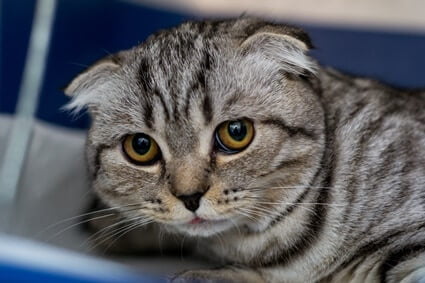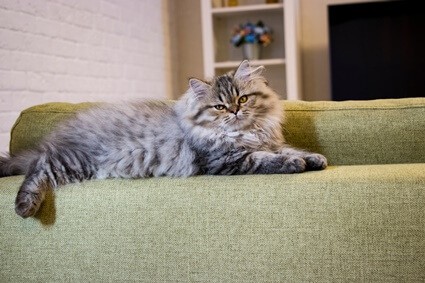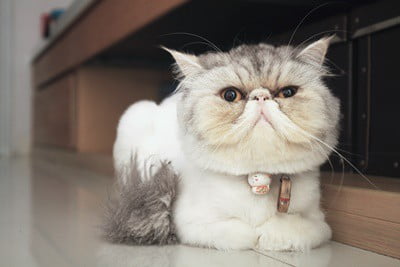We gush over doe-eyed Persian cats, but we wonder how healthy they are. After all, research suggests that flat-faced cats have more health problems than regular cats.
Brachycephalic cats struggle to breathe because their squashed noses obstruct airflow. Their raised jaws also cause dental issues and tear duct blockages, leading to tear-stained skin, eye problems, and facial dermatitis. Also, around 40% of Persian cats have Polycystic Kidney Disease (PKD).
The welfare of flat-faced cats is important, so we need to manage their health problems as best we can to protect them.
Why Do Flat-Faced Cats Have Health Problems?
To understand why these cats have so many health issues, you only need to look at their facial anatomy.
A brachycephalic cat has:
- A Shorter Skull – This causes facial bones to develop abnormally
- Undersized Nasal Chambers – This restricts airflow
- Stenotic Nares (Narrow Nostrils) – This also restricts airflow
- A Soft Palate (Roof of Mouth) that Is Too Long – This affects breathing and swallowing
- Narrowed Tear Ducts – This leads to eye and skin problems
- Protruding Eyeballs – This makes the eyes more vulnerable
- Entropion (Eyelids turned Inwards) – This causes multiple eye problems
- A Raised/Rotated Upper Jaw – This causes dental and tear duct issues
There are different grades of brachycephaly, ranging from mild (level 1) to severe (level 4).
Do all Flat-Faced Cats Have Health Issues?
The breeds that suffer the most are Persians, especially Peke-faced Persians and Exotic shorthairs.
Peke-faced Persians have been selectively bred over decades to create extreme features. When you view a Peke-faced Persian from side-on, their forehead, nose, and chin are in perfect vertical alignment.
Mildly brachycephalic cats have fewer health problems because their faces are not drastically altered. These include:
- Selkirk Rex
- Bombay
- Silver Persian (Chinchilla Cat)
- Burmilla
- Doll-faced Persian – These have large eyes and a short nose, but the face is not entirely flat. They are not the same as show-type Peke-faced Persians.
These breeds are still more prone to illness than regular cats.
Breathing Issues
Breathing issues are common in flat-faced cats. The medical term for this is Brachycephalic Obstructive Airways Syndrome (BOAS).
According to PLOS, the smaller the cat’s nose relative to its face, the more likely it is to have BOAS. Experimenters asked 239 cat owners to measure the width and length of their cat’s nose and the height and width of their cat’s face.
Using this info, they concluded that cats who have the greatest disparity between their face and nose size have the most health problems. Extreme breeds are more likely to have respiratory problems.
Why Do Flat-Faced Cats Struggle to Breathe?
It’s difficult for flat-faced cats to breathe because their nasal pathway is much narrower. Not only are the nostrils thinner, but the internal nasal chambers are also smaller. This slows down airflow and makes the cat feel bunged up.
It’s not just the structure of the cat’s nose but also its mouth that’s the problem. Flat-faced cats have an elongated soft palate, making it difficult to breathe and swallow.
The soft palate is the strip of tissue at the back of the cat’s throat that separates the nasal and oral cavities. If this strip of tissue is too big, this can cause coughing and spluttering.
It can also make it harder for the cat to catch its breath when swallowing.
Symptoms of BOAS
The symptoms of Brachycephalic Obstructive Airways Syndrome range from mild to severe. These include:
- Coughing
- Dyspnea – heavy, labored breathing
- Gasping for air after small amounts of exercise
- Snoring – possibly including Sleep Apnea
- Cyanosis – or low oxygen levels (a bluish/purple tinge to the gums)
- Swelling of the airways
- Fainting
These symptoms can cause distress, lethargy, and disturbed sleep.
Respiratory Diseases
In addition to general breathing problems, flat-faced cats are prone to the following respiratory diseases:
- Colds
- Sinus Infections
- Feline Asthma
- Allergies
- Contagious Feline Viruses, such as Feline Viral Rhinotracheitis (FVR) and Feline Calicivirus (FCV)
Respiratory diseases can be severe in Persian breeds, so disease prevention is essential.

Exercise and Heat Intolerance
Some people think flat-faced cats are lazy, but this isn’t the case. These cats prefer to stay cool and relaxed because heat and exercise can flare up their breathing problems.
When flat-faced cats become overheated, they may pant and struggle to catch their breath. This is made worse by the fact that Persians have long coats. Heatstroke is a real risk, so owners should know how to keep their cats cool in the summer months.
It’s typical for Persians to get out of breath after bursts of activity. Limiting their physical activity can help with BOAS, but it can lead to other health problems. Persians are more likely to be overweight due to their sedentary lifestyles.
Watery Eyes
Flat-faced cats can look as if they’ve been crying due to their abnormal facial anatomy.
According to Sage, Peke-faced Persian cats have a dorsally rotated upper jaw, and this means that the top jaw rotates upwards and causes the canines to grow awkwardly. As well as causing dental problems, this places pressure on the cat’s tear ducts.
When tear ducts work normally, they drain tears into the nasal cavity. Because the tear ducts are partially compressed, this causes a build-up of tears in the eyes. These tears cannot enter the tear ducts (and nasal cavity), so they flow down the cat’s face instead.
Watery eyes can cause discomfort and itching. In extreme cases, the tears may obscure vision and cause eye infections.
Facial Dermatitis
Persian cats are particularly prone to facial dermatitis.
The symptoms of dermatitis include:
- Redness
- Itching
- Black spots on the fur
- Crusting
- Bleeding and scabbing of the skin due to scratching
Facial dermatitis may be caused or aggravated by watery eyes. Some cats get bad facial dermatitis but don’t seem to get watery eyes.
This suggests other factors may also cause dermatitis in flat-faced breeds. A study on Wiley suggests flat-faced breeds may be genetically predisposed to facial dermatitis.
Facial dermatitis can be stubborn to treat in Persians and Exotic breeds.
Skin and Fur Problems
Besides facial dermatitis, they’re prone to other skin and fur problems. Longhaired breeds (Persian, Himalayan, British Longhair) struggle the most.
These problems include:
- Dirty bottom – Flat-faced cats tire easily, so they don’t always have the energy to clean their bums. Their long hair can also obstruct access to their bottom and undersides.
- Fleas and mites – Longhaired cats are also more prone to fleas and mites. Most pedigree cats are kept indoors, so this minimizes the risk to an extent. But flat-faced cats that socialize with other animals are prone to fleas and mites.
- Fungal skin infections – Most cats have a strong immunity to the Microsporum canis fungi, but Persian cats do not. This means they are susceptible to Microsporum canis fungal infection. According to UFAW, this infection causes intense scratching, bleeding, and damage to the skin. This fungal infection can be difficult to cure.
These issues are caused or aggravated by the abnormally long coats. The UFAW says that Microsporum canis fungal infection would be much less of an issue if Persians had regular-length coats.
Dental Problems
Extremely brachycephalic cats have rotated (raised) upper jaws, and this causes teeth to grow at strange angles. As a result, cats get food stuck between their teeth and may develop periodontal disease.
Doing dental work is a challenge because it may cause damage to the nasal system or tear ducts.
Flat-faced cats are known for being fussy eaters because their jaw structure limits what they can eat. For example, they find it hard to lift kibble pieces with their teeth because their bite is so shallow. They may also struggle to drink water from a conventional water bowl.
Flat-faced cats can be messy eaters. Because their chin is in line with their nose and mouth, they tend to get messy chins after eating. This can stain the fur and cause irritation.
Eye Problems
Big, child-like eyes are endearing, but they’re not healthy. Flat-faced cats can have multiple eye conditions, such as:
- Exposure keratopathy – Because the eyes protrude, the cornea (the film on the front of the eye) is more vulnerable to dust, pollen, and other irritants. Cats with protruding eyes also have decreased sensitivity, so they don’t always realize if something is irritating their eyes. Once the cornea has become irritated, this can lead to eye damage and ulceration.
- Entropion – This is when the cat’s eyelids turn inwards and the hairs on the outside of the eyelids rub on the corneas. This causes the eye to become irritated and can cause ulcers. Corneal ulcers are slow to heal in Persian cats.
- Nasal fold trichiasis – This is when the skin folds on the nose rub against the cornea.
- Corneal sequestra – According to Springer, Persian cats are predisposed to Corneal Sequestra. This happens when the cat’s cornea becomes damaged, causing black or brown pigmentation to develop on the cornea.
Does my Persian Cat Have Eye Problems?
The above eye conditions can cause irreversible damage, so you should know how to spot the signs.
Symptoms include:
- Cat is rubbing its face and eyes excessively
- Squinting and sensitivity to light
- Blinking but not being able to close eyes completely
- Excessive blinking
- Eye discharge
- Pigmentation or clouding of the corneas
- Walking or jumping difficulties
Polycystic Kidney Disease
According to BMJ, 49% of Persian cats (in the UK) have Polycystic Kidney Disease. This varies throughout the world, but studies show the prevalence is between 36 and 49%.
Close relatives of the Persian cat (Himalayan, Burmese, Chinchilla cat) can also be affected by PKD, but the risk is reduced with these breeds.
Cats with this condition are born with tiny fluid sacs in their kidneys. Although the sacs don’t cause problems during the first years of life, they’ll grow bigger and eventually lead to kidney failure.
Symptoms of PKD (and Kidney failure) tend to emerge in middle-to-older age, including:
- Weight loss
- Increased thirst and frequent urination
- Weak muscles
- Vomiting
- Fainting and Seizures
There’s no treatment for this disease, but certain medications can slow its progression.
How Is Polycystic Kidney Disease Inherited?
PKD is an autosomal dominant condition.
This means only one parent needs to have the gene to pass it on (2 cats with this gene cannot create viable offspring). If one parent has the gene, there’s a 50:50 chance of passing the condition onto a kitten.
So, if a cat with PKD is used for breeding, it will pass on PKD to many kittens throughout its breeding life.
Cats can be tested to check if they hold the PKD gene or not. If you’re going to get a Persian, Exotic, or Himalayan kitten, ask the breeder if they have tested the parents for PKD.
This ensures your kitten is healthy and shows breeders there is a demand for this genetic information, and this encourages breeders to be more responsible.
Due to developments in genetic testing, Polycystic Kidney Disease is becoming less common in Persian breeds. However, more could be done to eliminate this condition.
The UFAW stated that PKD could be eliminated if all breeders carried out genetic testing.
How To Care for A Flat-faced Cat
Many of these health problems cannot be cured due to the cat’s brachycephalic features cause them. However, these health conditions can be managed. The level of care flat-faced cats receive determines their quality of life.
The following tips show you how to care for a flat-faced cat:
Keep a Persian Cat Cool
Persian cats can quickly overheat due to their long coats. Breathing problems are exacerbated by heat, so you should keep your cat cool.
Here are some options to consider:
- Cooling pad. These are blankets with temperature cooling technology.
- Let your cat go into the coldest parts of the house, such as the cellar utility room or bathroom.
- Place an ice cube in your cat’s water bowl.
- Buy a granite or marble slab for your cat to sleep on. Place a couple of slabs in different rooms of the house.
Create a Calming Environment
Excitement and anxiety can aggravate breathing problems in flat-faced cats. So, as well as keeping your cat cool, you should keep them calm.
Consider the following:
- Some flat-faced breeds, especially Persians, hate noise. Make your home quieter and give your cat plenty of hiding places if visitors come over.
- Cats with BOAS struggle to fall asleep. If you see your cat napping, don’t wake it up as this could cause distress and anxiety. Due to their breathing problems, it could take them hours to fall asleep again.

Prevent Respiratory Diseases
Respiratory diseases are more common in flat-faced breeds. To prevent these, do the following:
- Eliminate common allergens such as house dust, grass pollen, and beef-based cat foods. Vacuuming the house daily with remove house dust. When the pollen count is high, shut all windows and doors and keep your cat inside.
- Vaccinate your cat for common viral infections. This is important if your cat is going to socialize with other animals.
- If you are going away, arrange care for your cat at home, rather than sending them off to a cattery. This will reduce the risk of infection.
- Regularly check for signs of illness. Symptoms include swollen sinuses, a runny or crusty nose, and loss of appetite.
Grooming Requirements
Persian, Himalayan, and British Longhaired cats require daily grooming. These cats have very long coats that knot and mat easily. The risk of skin infections is also higher in these breeds.
Use a combination of tools to groom your cat effectively. You can use a boar-bristled brush to distribute the natural oils and make your cat’s coat soft.
A wire-slicker brush is good for removing old, dead hair, and a fine-toothed comb is good for detangling knots and detecting fleas.
If your cat repeatedly gets heatstroke or struggles to keep itself clean, it would be kinder to trim the fur.
Feeding Requirements
Persian cats can be fussy and messy eaters. To assist a Persian cat, you can:
- Provide a shallow water dish or a water fountain, which are easier to drink from.
- Provide wet food rather than kibble. Persians benefit from the extra fluids found in wet food.
- Choose hypoallergenic cat food as Persian cats are more prone to food allergies.
Can Breathing Problems in Cats be Cured?
Cats with mild brachycephaly may have minor respiratory symptoms (if at all). However, cats with extremely flat faces will experience more severe breathing problems.
The brachycephalic skull puts pressure on the cat’s respiratory system, so breathing problems cannot be cured.
Mild symptoms can usually be left alone (though you should keep the cat cool and calm). Severe breathing problems may be treated with surgery.
If surgery is performed, this will improve rather than cure the problem.
Are Flat-Faced Cats Considered Healthy?
Cats with extremely flat faces can’t be considered healthy. Their faces are so far removed from typical cats’ faces that we cannot ignore the associated health risks.
In the last few years, the welfare of brachycephalic cats has been on the agenda.
- In 2018, International Cat Care welcomed the proposal to ban designer pets in Scotland. They have also withdrawn pictures of brachycephalic dogs (i.e., Pugs) and flat-faced cats from any of their advertising.
- Breeders in Germany are not allowed to use cats whose nose tip is positioned above the lower eyelid.
- Researchers have called for breeders to look at the angle of the upper jaw to determine whether the cat is suitable for breeding or not. Cats with lifted jaws and upper canines are likely to suffer health problems, so they should not be used for breeding.
- Genetic testing for Polycystic Kidney Disease is now becoming cheaper and easier. Vets and animal welfare organizations are encouraging breeders to carry this out as standard. Buyers are also being told to ask about this information when purchasing a kitten.
- Some Cat Fancying Associations are considering reassessing the criteria for Persian cats.
These developments suggest that very flat-faced Persians are becoming less acceptable and less desirable.
Leonardo Da Vinci said that “the smallest feline is a masterpiece.” In other words, cats are so perfectly formed that we don’t need to change them. Cats with normal feline features are the ones that live healthier, fuller lives.

